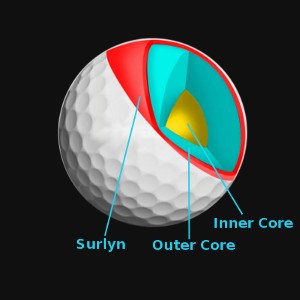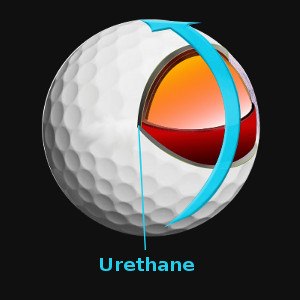
When it comes to golf ball covers, there are two primary materials used: Surlyn and urethane. Each has its own characteristics and performance attributes. Let's explore the differences between Surlyn and urethane covers:
Surlyn Cover:
- Durability: Surlyn covers are known for their exceptional durability. They are resistant to scuffs, cuts, and abrasions, making them ideal for golfers who tend to hit the ball with more force or frequently encounter hazards such as trees or cart paths.
- Distance: Surlyn covers are designed to maximize distance. They provide a lower spin rate off the tee, which helps golfers achieve longer drives. The low spin also helps reduce side spin, resulting in straighter shots.
- Affordable: Golf balls with Surlyn covers are generally more affordable compared to those with urethane covers. They are a popular choice among recreational golfers who prioritize durability and distance without breaking the bank.
- Control: While Surlyn covers offer decent control on full shots, they tend to have less spin and feel around the greens. This can make it more challenging to generate backspin or control trajectory on approach shots and short game shots.
Urethane Cover:
- Spin and Control: Urethane covers are revered for their exceptional spin and control characteristics. They create more friction with the clubface, allowing skilled golfers to generate higher levels of backspin. This spin provides more control over shot shape, trajectory, and stopping power on the greens.
- Feel: Urethane covers provide a soft and responsive feel, often described as “tour-level” feel. This enhanced feel gives golfers better feedback on their shots, allowing for more precise shot-making.
- Greenside Performance: Urethane covers excel in providing excellent greenside performance. They offer the ability to stop the ball quickly and impart more spin on chips, pitches, and bunker shots. This makes them a preferred choice for golfers who rely on their short game prowess.
- Shot-Shaping: Urethane covers are more receptive to shot-shaping due to their ability to generate spin. Skilled players can manipulate the ball flight and work the ball both ways with greater ease.
- Premium Performance: Urethane-covered golf balls are commonly used by professional golfers and advanced amateurs due to their premium performance attributes. They are designed to optimize both distance and control, making them suitable for players who prioritize precision and versatility.
Ultimately, the choice between Surlyn and urethane covers depends on your individual playing style, skill level, and preferences. If you value durability and distance, Surlyn covers can be a cost-effective option. On the other hand, if you prioritize spin, control, and greenside performance, urethane covers are the way to go. It's important to experiment with different golf balls and covers to find the one that suits your game and provides the performance you desire.
With balata having gone the way of the 8-track tape, most golf balls feature a cover made from either Surlyn or urethane. When choosing a ball that’s right for your game, it’s important to know the difference.
Surlyn is an ionomer resin introduced by DuPont in the 1960s. It’s been the material of choice for the covers of so-called “distance balls” – like Top-Flite and Pinnacle products – for decades. Surlyn is extremely durable and will not cut or scuff through normal use (although mower blades and cart paths can damage it), making it the preferred cover for most amateur golfers.
The primary drawback to Surlyn balls is that they don’t provide the backspin or feel demanded by professionals and many low-handicap amateurs. And that’s where urethane comes in.

Urethane is softer than Surlyn and delivers higher spin rates on iron and wedge shots. Skilled golfers prefer this control and, because they generate high clubhead speeds, lose little if any distance compared to Surlyn balls. Urethane is technically softer than balata – the cover material of high-performance balls of the past — but is actually more durable and less prone to cuts and scrapes.
In a nutshell, Surlyn-covered golf balls are generally less expensive, slightly more durable and may provide a little more distance than urethane models, but don’t provide the spin needed to stop shots quickly around the greens. Golfers who don’t mind spending more for urethane will see most benefits in the short game while giving up very little in the distance and durability departments.
Q&A:
Q1: What are the main differences between Surlyn and Urethane golf ball covers? A1: The main differences between Surlyn and Urethane golf ball covers lie in their performance characteristics. Surlyn covers are more durable and provide a firmer feel with less spin, making them ideal for beginners and high-handicap players. Urethane covers, on the other hand, offer better control, more spin, and a softer feel, making them preferred by low-handicap players and professionals.
Q2: How does the durability of Surlyn and Urethane covers compare? A2: Surlyn covers are generally more durable and resistant to scuffs and scratches than Urethane covers. They tend to maintain their appearance and performance for a more extended period, making them suitable for golfers who tend to lose or damage balls frequently.
Q3: Which cover material provides more spin around the greens? A3: Urethane covers provide more spin around the greens due to their softer nature and better interaction with the clubface. This increased spin allows for more control over approach shots and shots around the green.
Q4: Do Surlyn covers offer any advantages for golfers? A4: Yes, Surlyn covers have lower spin rates, which can help reduce slices and hooks for players who struggle with excessive side spin. Additionally, they are more affordable than Urethane-covered balls, making them a cost-effective option for recreational golfers.
Q5: Are Urethane-covered balls more expensive than Surlyn-covered balls? A5: Yes, Urethane-covered balls tend to be more expensive than Surlyn-covered balls due to the higher cost of materials and manufacturing processes.
Q6: Which cover material is better suited for distance shots? A6: Surlyn-covered balls are generally better suited for distance shots due to their lower spin rates. The reduced spin can result in longer, straighter shots off the tee.
Q7: Do Urethane-covered balls perform better in wet or rainy conditions? A7: Urethane-covered balls tend to perform better in wet or rainy conditions due to their ability to generate more spin and control. The increased spin helps the ball grip the greens better and reduces the chances of skidding on wet surfaces.
Q8: Can I find both Surlyn and Urethane-covered balls from the same golf ball brand? A8: Yes, many golf ball brands offer a range of ball models with both Surlyn and Urethane covers to cater to different golfer preferences and skill levels.
Q9: Do professional golfers predominantly use Urethane-covered balls? A9: Yes, most professional golfers prefer Urethane-covered balls for their superior control and spin performance, which is crucial for precision shots on the PGA Tour.
Q10: Are there any drawbacks to using Urethane-covered balls for high-handicap players? A10: The higher spin rates of Urethane-covered balls can lead to more erratic shots for high-handicap players who may struggle with consistency. Surlyn-covered balls may offer a more forgiving and straightforward option for such players.
Q11: Are Surlyn-covered balls suitable for advanced players and professionals? A11: While Surlyn-covered balls are primarily designed for recreational players and beginners, some low-handicap players may still find them suitable for specific situations, such as windy conditions or when distance off the tee is a priority.
Q12: How can golfers determine which type of ball cover is best for their game? A12: Golfers can determine the best ball cover for their game by considering their skill level, swing characteristics, and shot preferences. Trying out both Surlyn and Urethane-covered balls during practice rounds or golf ball fittings can help identify which cover material suits their game better.
The other major factor that affects performance is a golf ball’s core composition. While research of different brands and models can guide you toward the right ball for your skill set, a comprehensive golf ball fitting is your best bet.
Golf Ball Videos:
– Compression Video
– Spin Video
– Dimples Video
– Golf Ball Brands Video
– Titleist Video
– Understanding Spin Video





